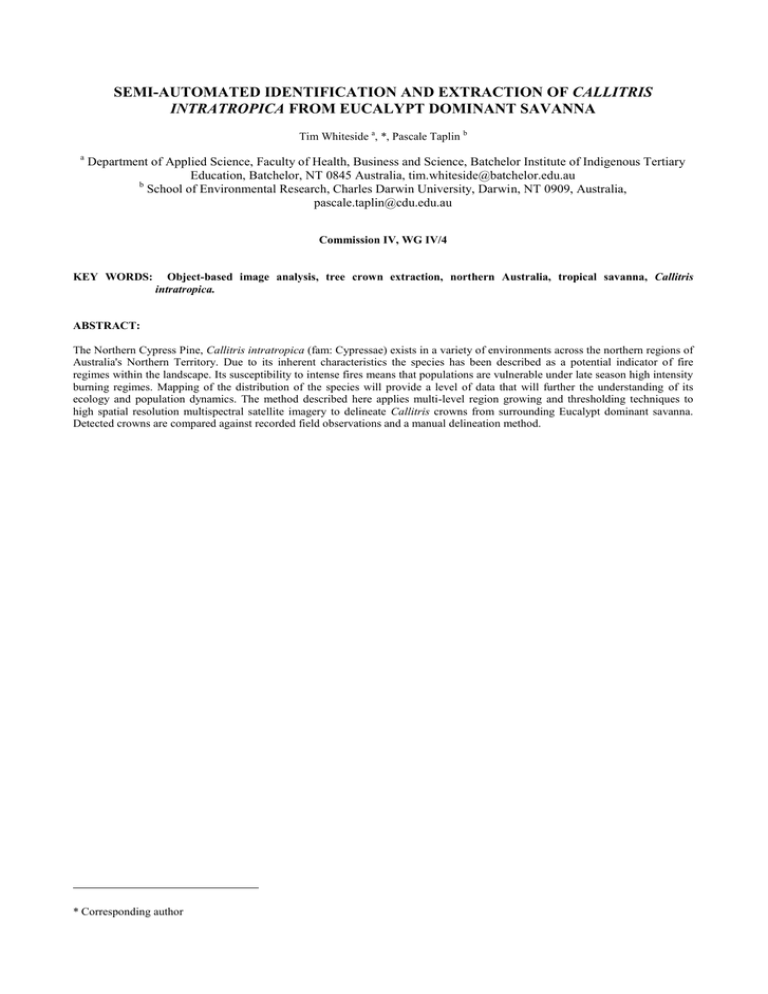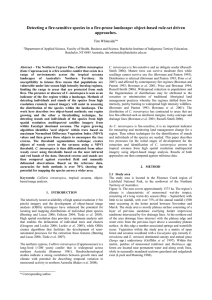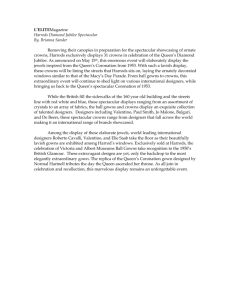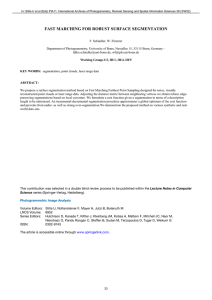CALLITRIS INTRATROPICA
advertisement

SEMI-AUTOMATED IDENTIFICATION AND EXTRACTION OF CALLITRIS INTRATROPICA FROM EUCALYPT DOMINANT SAVANNA Tim Whiteside a, *, Pascale Taplin b a Department of Applied Science, Faculty of Health, Business and Science, Batchelor Institute of Indigenous Tertiary Education, Batchelor, NT 0845 Australia, tim.whiteside@batchelor.edu.au b School of Environmental Research, Charles Darwin University, Darwin, NT 0909, Australia, pascale.taplin@cdu.edu.au Commission IV, WG IV/4 KEY WORDS: Object-based image analysis, tree crown extraction, northern Australia, tropical savanna, Callitris intratropica. ABSTRACT: The Northern Cypress Pine, Callitris intratropica (fam: Cypressae) exists in a variety of environments across the northern regions of Australia's Northern Territory. Due to its inherent characteristics the species has been described as a potential indicator of fire regimes within the landscape. Its susceptibility to intense fires means that populations are vulnerable under late season high intensity burning regimes. Mapping of the distribution of the species will provide a level of data that will further the understanding of its ecology and population dynamics. The method described here applies multi-level region growing and thresholding techniques to high spatial resolution multispectral satellite imagery to delineate Callitris crowns from surrounding Eucalypt dominant savanna. Detected crowns are compared against recorded field observations and a manual delineation method. * Corresponding author 1. INTRODUCTION and is located near two of the park’s major features, Florence Falls and Buley Rockhole (CCNT, 1992). Recent advances in remote sensing have improved analysis capabilities for locating and mapping distributions of individual plant species (Bunting and Lucas, 2006; Erikson, 2004; Tiede et al., 2005). High spatial resolution (<5m pixels) imagery data provides a minimum analysis unit that enables the delineation of individual trees and clusters (Gougeon and Leckie, 2006; Leckie et al., 2005). Object-based image analysis creates algorithms that facilitate the development of semi-automated processes for the extraction these features (Bunting and Lucas, 2006; Tiede et al., 2007). The northern cypress, Callitris intratropica (Cuppressaceae) is a conifer that is widespread across northern Australia (Baker et al., 2008). It is a long-lived tree (>200years) and thus spans the time from pre-European colonisation (Hammer, 1981). Estimates of the age of some living trees are over 400 years in savanna in Kakadu National Park (Prior et al., 2007). Dendrochronological studies indicate a strong correlation between growth rates and climate, showing the potential application of this species for reconstructing a history of variation in monsoonal activity in northern Australia (Baker et al., 2008). C. intratropica is fire-sensitive and an obligate seeder (RussellSmith, 2006). Mature trees have thick bark and can survive moderate but not intense fires while seedlings cannot survive even the mildest fire (Bowman and Panton, 1993). Patterns of distribution are shown to be relictual (Bowman and Panton, 1993; Prior et al., 2007), and contemporary fire regimes have been deleterious to the distribution and populations (Bowman and Panton, 1993; Bowman et al., 2001; Price and Bowman, 1994; Russell-Smith, 2006). Widespread reduction in populations and the fragmentation of distributions may be attributed to the change in fire regimes brought about by the cessation or minimisation of traditional Aboriginal land management practices (Bowman and Panton, 1993; Bowman et al., 2001). With the land management changes, fires shifted from low intensity, patchy burning to widespread high intensity wildfires. The distribution of C. intratropica is contracting to where seedlings are able to escape the impacts of fire (areas including rainforest margins, and fire-protected microsites within savanna such as rocky outcrops and drainage lines) (Bowman et al., 2001; Russell-Smith, 2006). As this species is fire-sensitive it can be important indicator of land management change. Monitoring the changes in populations and their distribution enables the development of a picture of land management for a region. This can be done through the identification of stands and individuals of the species. This paper describes a process (in the early stages of development) for the extraction and identification of C. intratropica crowns in tropical savanna from high spatial resolution multispectral imagery using object-based image analysis. Results of the extraction are then compared against reference data. 2. METHOD 2.1 Study area The study area is part of the Florence Creek region of Litchfield National Park, in the northwest of the Northern Territory of Australia (Figure 1). The area covers approximately 1373 ha * Corresponding author Figure 1: Location of the study site The region’s climate is characteristic of the wet/dry tropics; consisting of a long dry season (May – September) with little to no rainfall, with over 75% of the annual rainfall (1500 mm) occurring in the period between November and March. Maximum daily temperatures vary from just under 32°C in June and July to over 36°C in October and November. The study area is mostly plateau surface consisting of a layer of pervious sandstone overlying harder impervious sandstone intersected by few drainage lines. At the northern end of the scene where drainage lines intersect with the plateau edge and water exits from the pervious layer exists a secondary plateau surface. At the edge a number of incisions and associated springs and waterfalls occur. This terrain contains areas of shading and slope which influence irradiance within imagery and thus making per-pixel analysis difficult. Vegetation within the study area is a matrix of open forest and savanna woodland with a Eucalyptus spp. (mostly E. tetradonta and E. miniata) dominated canopy and annual grass (Sarga spp.) understorey (Griffiths et al., 1997). Within this matrix, patches of monsoonal rain forest are located near permanent water. Melaleuca spp. forests occur along creek lines and share overlapping species with the rain forest (Lynch and Manning, 1988). 2.2 Data and Pre-processing The primary dataset for this project was a DigitalGlobe QuickBird image (Figure 2). The time of capture was 11.09 am (local time) on 28 August 2004. The panchromatic (450900μm) and multispectral (blue (450-520µm), green (420600µm), red (630-690µm) and near infrared (NIR) (760900µm)) bands were utilised. Ground resolution of this imagery is 0.6 (panchromatic) and 2.4 (multispectral) metres at nadir. Off-nadir angle for the scene is 8.9 degrees. Data were adjusted to top-of-atmosphere radiance values (Krause, 2003) and the image was geometrically corrected to a previously georeferenced aerial orthophoto of the area with an accuracy error of less than 0.5 pixels. The International Archives of the Photogrammetry, Remote Sensing and Spatial Information Sciences, Vol. XXXVIII-4/C7 while the second finer segmentation (level 0) is used to identify and classify tree crowns. The first segmentation created objects that provide broad land cover classes to separate Eucalypt or savanna vegetation from closed forest riparian, grassland and flood plain vegetation. The segmentation at this level was undertaken using the multiresolution segmentation algorithm within the Definiens Developer V7 software application. This region growing segmentation algorithm that partitions images into objects based on several homogeneity criteria (Benz et al., 2004). The algorithm balances homogeneity of shape of the objects against spectral homogeneity. The shape criterion is split into two subcriteria: smoothness versus compactness (smooth borders opposed to compact shapes). Object size is determined by the heterogeneity criterion (scale parameter) which although unitless determines the maximum allowable heterogeneity of pixels within objects. For this level of segmentation, only the multispectral layers were considered and Table 1 shows the details of the parameters for segmentation and figure 2b displays the resultant objects. Figure 2: The QuickBird scene used in this study, RGB=bands 4, 3, 2 An additional derivative ‘decorrelation stretch’ data set was also created by applying a contrast-stretching principal component (PC) transformation to the image and then retransforming the subsequent PC image to the original coordinates of the image for display (Gillespie et al., 1986). The transformation produced four additional 32-bit layers with the third layer DS3 being included here (Figure 3) due to its potential for differentiation between Eucalypt and non-Eucalypt dominant communities. Table 1: Parameters for the broad level (level 1) of segmentation. Segmentation Scale Colour Compactness / method parameter /Shape Smoothness Multiresolution 200 0.4 / 0.6 0.8 / 0.2 At the broad segmentation level objects were classified based on a threshold of the DS3 layer. Objects representing riparian forest and grassland (with a mean DS3 value equal to or less than 0.445) were classified as non-Eucalypt dominant communities and excluded or masked out from further segmentation and analysis. Objects possessing a mean DS3 value greater than 0.445 represent Eucalypt dominant vegetation communities and were thus included in the finer level 0 segmentation and extraction processes. The level 0 segmentation created objects that could be utilised as ‘seeds’ identifying the location of tree crowns and was conducted within objects identified as containing Eucalypt dominant vegetation. The chessboard segmentation algorithm was used to create square objects 2x2 panchromatic pixels in size (1.44m2) 2.4 Tree crown identification and extraction A virtual derivative layer (NDVI) was created from the dataset using the customisable arithmetic feature within Definiens Developer. The NDVI feature is based on the Normalised Difference Vegetation Index and utilises mean object values of the near infrared and red bands of the multispectral image. Figure 3: A sample of the study areas displaying the greyscale image of the third (DS3) layer of the decorrelation stretch used in this study. 2.3 Analysis An object-based approach was used to extract tree crowns from the imagery. The process involved two levels of segmentation and classification. The first broader level (level 1) of segmentation identified areas of Eucalypt dominant vegetation The rule set created to identify tree crowns follows five steps: Identifying local maxima; Growing the seed objects to tree crown objects; Splitting objects into crowns and clusters; Splitting clusters into crowns; Delineating C. intratropica crowns and clusters. 2.4.1 Identifying local maxima Seed objects that lie within tree crowns were created by identifying local maxima objects based on their mean NDVI value and subject to a distance measure. The search distance The International Archives of the Photogrammetry, Remote Sensing and Spatial Information Sciences, Vol. XXXVIII-4/C7 2.4.2 Growing the seed objects to tree crown objects The iterative region growing algorithm ‘grew’ the seed objects to engulf adjoining objects based upon the NDVI criterion until the threshold of 0.2 was met and the region growing terminated. The value of 0.2 was observed as a distinct cut-off between a tree crown and its surroundings. Following the region growing, smaller classified objects, less than 10m2, where classed as fragments or scraps and those abutting larger objects were then merged to the larger objects. Those not abutting larger objects were identified as not being crowns. Unclassified objects fully enclosed by crown objects were also classified as belonging to crowns and merged into the larger object. 80 Mean Radiance was 10 panchromatic pixels as this was determined the best distance for seed extraction for this scene. Lesser ranges of distance (<10) tended to over supply the seeds while ranges greater that 10 did not detect enough crowns. 60 Callitris 40 Eucalypt 20 0 Blue Green Red Band NIR Figure 4: Mean radiance band values for objects representing Callitris intratropica compared to objects representing Eucalypts. 3. RESULTS AND DISCUSSION 2.4.3 Splitting objects into crowns and clusters. Classified objects were then determined to be either individual crowns or clusters of crowns based on three shape-based criteria: area, length/width ratio, and shape index. For the area criterion, objects greater than 180m2 were considered potential clusters of crowns and not an individual crowns. A 2:1 length/width ratio used to differentiate between crowns and potential elongated rows of crowns. The shape index (SI) describes the fractal characteristic of the object relating circumference to area. Values for the SI range between 1 and ∞, with 1 approximating a square. In this case, objects that met the above two criteria and have a SI greater than 1.3 were also considered clusters and not crowns. 2.4.4 Splitting of clusters into crowns Objects identified through the above procedure as clusters were re-segmented to objects 2 x 2 panchromatic pixels in size and local maxima were identified based on NDVI values with a shorter distance of 8 pixels. Further iterative region growing using the maxima as seeds was undertaken within the cluster objects to a threshold NDVI value of 0.225. A second iteration was then undertaken on objects less than 10m2 to a threshold of 0.2. Figure 5 shows the results of the level 1 segmentation (a) and subsequent classification (b). Areas in grey are classified nonEucalypt and not analysed. (a) 2.4.5 Delineating C. intratropica crowns and clusters The canopy of C. intratropica trees are characteristically different spectrally to other trees within the savanna. A comparison of mean object layer values versus the dominant Eucalpyts, shows the spectral values are lower across all bands, most notably in the Red and NIR (Figure 4). This distinct spectral signature was use to be extract objects representing C. intratropica crowns using class rules based on mean object layer values for Red and NIR. Tree crown objects were determined to be potentially C. intratropica if their mean Red and mean NIR values were less than 30 and 56 respectively. 2.5 Validation Validation of the identified C. intratropica crowns and clusters was conducted against a sample (64) of field-recorded and image-observed locations of trees and clusters. A handheld GPS (Global Positioning System) unit was used to obtain the coordinates of these features. No measure of accuracy was recorded. Further reference data was delineated using visual interpretation, identification and marking of C. intratropica crowns using pan-sharpened QuickBird imagery over the study area on Google Earth. (b) Figure 5: A portion of the study areas showing (a) DS3 derivative band with broader Level 1 segmentation overlaid and, (b) areas of non-Eucalypt dominant vegetation communities masked out. Within the scene 3424 objects were identified as potentially C. intratropica (Figure 6). Visual inspection shows good delineation of known individuals and clusters (Figure 7). Further inspection shows trees in some areas were identified as C. intratropica when they were actually other canopy. For example, a number of small areas of monsoon and riparian The International Archives of the Photogrammetry, Remote Sensing and Spatial Information Sciences, Vol. XXXVIII-4/C7 forest were not masked out in the first classification. Some of these were included in the identified objects. In addition, some trees located on steep terrain and affected by shading were also detected. includes the refinement of thresholds to better discriminate C. intratropica crowns, adjustment of the non-Eucalypt mask using different segmentation parameters to better cover these areas. Even further work will take this process and apply it on a broader scale both spatially and temporally. Investigate the application of this technique with other high and very high spatial resolution data. 5. REFERENCES Baker, P. J., Palmer, J. G. and D'Arrigo, R., 2008. The dendrochronology of Callitris intratropica in northern Australia: annual ring structure, chronology development and climate correlations, Australian Journal of Botany, 56 (4), 311-320. Benz, U., Hofmann, P., Willhauck, G., Lingenfelder, I. and Heynen, M., 2004. Multi-resolution, object-oriented fuzzy analysis of remote sensing data for GIS-ready information, ISPRS Journal of Photogrammetry and Remote Sensing, 58, 239-258. Figure 6: Extracted potential C. intratropica crowns within the study area. Bowman, D. J. M. S. and Panton, W. J., 1993. Decline of Callitris intratropica R.T. Baker & H.G. Smith in the Northern Territory: implications for pre- and postEuropean colonization fire regimes, Journal of Biogeography, 20 (4), 373-381. Bowman, D. M. J. S., Price, O., Whitehead, P. J. and Walsh, A., 2001. The 'wilderness effect' and the decline of Callitris intratropica on the Arnhem Land Plateau, northern Australia, Australian Journal of Botany, 49 (5), 665-672. (a) (b) 0 20 40 Bunting, P. and Lucas, R., 2006. The delineation of tree crowns in Australian mixed species forests using hyperspectral Compact Airborne Spectrographic Imager (CASI) data, Remote Sensing of Environment, 101 (2), 230-248. 80 Meters Figure 7: Example. CCNT, 1992. Litchfield National Park Plan of Managment, Conservation Commission of the Northern Territory, Darwin. Table 2 shows crowns and clusters identified against reference data. Of the locations identified in the reference data, 65% were matched to extracted crowns. This shows that the process has potential. The locational accuracy of the reference data may have attributed some of the error ss field observations were recorded using a handheld GPS and others obtained through visual delineation of imagery. Incorrect tree species identification would also contribute to the error. Erikson, M., 2004. Species classification of individually segmented tree crowns in high-resolution aerial images using radiometric and morphologic image measures, Remote Sensing of Environment, 91, 469477. Table 2: No. of C. intratropica crowns against reference data. Reference % Extracted 42 65 Not extracted 22 35 Total 64 100 Gillespie, A. R., Kahle, A. B. and Walker, R. E., 1986. Color enhancement of highly correlated images. I. Decorrelation and HSI contrast stretches, Remote Sensing of Environment, 20, 209-235. Gougeon, F. A. and Leckie, D. G., 2006. The Individual Tree Crown approach applied to Ikonos images of a coniferous plantation area, Photogrammetric Engineering & Remote Sensing, 72 (11), 1287-1297. 4. CONCLUSION The work described here is in the early stages of development. Describes a novel object-based region-growing approach to identify and map a species of tree that is under threat from altered land management practices. The approach definitely has potential and some further research is required. Further work Griffiths, A. D., Woinarski, J. C. Z., Armstrong, M. D., Cowie, I. D., Dunlop, C. R. and Horner, P. G., 1997. Biological Survey of Litchfield National Park, Report No. 62, PWCNT, Darwin. The International Archives of the Photogrammetry, Remote Sensing and Spatial Information Sciences, Vol. XXXVIII-4/C7 Hammer, G. L., 1981. Site classification and tree-diameterheight-age relationships for cypress pine in the Top End of the Northern Territory, Australian Forestry, 44 (1), 35-41. Krause, K., 2003. Radiance conversion of QuickBird data, DigitalGlobe, Longmont, Colorado. Leckie, D. G., Gougeon, F. A., Tinis, S., Nelson, T., Burnett, C. N. and Paradine, D., 2005. Automated tree recognition in old growth conifer stands with high resolution digital imagery, Remote Sensing of Environment, 94 (3), 311-326. Lynch, B. T. and Manning, K. M., 1988. Land resources of Litchfield Park, Technical Report No. 36, Conservation Commission of the Northern Territory, Darwin. Price, O. and Bowman, D. M. J. S., 1994. Fire-Stick Forestry: a matrix model in support of skilful fire management of Callitris intratropica R. T. Baker by north Australian Aborigines, Journal of Biogeography, 21 (6), 573580. Prior, L. D., Bowman, D. M. J. S. and Brook, B. W., 2007. Growth and survival of two north Australian relictual tree species, Allosyncarpia ternata (Myrtaceae) and Callitris intratropica (Cupressaceae), Ecological Research, 22 (2), 228-236. Russell-Smith, J., 2006. Recruitment dynamics of the long-lived obligate seeders Callitris intratropica (Cupressaceae) and Petraeomyrtus punicea (Myrtaceae), Australian Journal of Botany, 54 (5), 479-485. Tiede, D., Hochleitner, G. and Blaschke, T., 2005. A full GISbased workflow for tree identification and tree crown delineation using laser scanning, International Archives of Photogrammetry, Remote Sensing and Spatial Information Sciences, XXXVI (Part 3/W24). Tiede, D., Lang, S. and Maier, B., 2007. Transferability of a tree-crown delineation approach using region-specific segmentation, Proceedings of XIII Brazilian Remote Sensing Symposium, 21-26 April, Florianopolis, Brazil, INPE, 1883-1890 pp.







